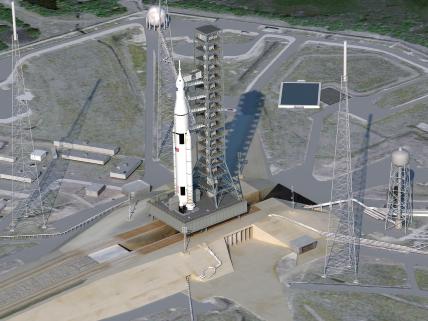After months of speculation, NASA has confirmed the final design of the Space Launch System (SLS) - a heavy lift launch vehicle expected to launch NASA payloads into deep space by 2017.
The first rockets will be capable of lifting 70 tonnes to low Earth orbit (LEO), and later versions will be scaled up to 130 tonnes.
With a minimum of 10% greater thrust than the massive Saturn V rocket, which took the Apollo astronauts to the Moon, SLS will be the largest and most powerful launch vehicle ever built.
The first stage of SLS will be powered by three Rocketdyne RD-25D/E rockets, also known as Space Shuttle main engines (SSME), assisted in the first minutes of flight by two five-segment solid rocket boosters also derived from Shuttle systems.
Later launch systems may have as many as five SSMEs. The second stage will be powered by the Rocketdyne J-2X, currently under development.
The solid rocket boosters will have a role in the first launch, but launches thereafter will use boosters still to be selected in an open competition, using either solid or liquid fuels.
 |
|---|
| Copyright: NASA |
The competition is expected to begin shortly, according to NASA, with an industry day to be held on 29 September.
US-based Alliant TechSystems (ATK), the solid rocket boosters' manufacturer, conducted the first full-scale test of the booster on 8 September. The test was successful, according to ATK.
Bringing the launch system to first flight, scheduled for 2017, is expected to cost $18 billion.
Details of the vehicle's cost beyond 2017, including the development of the 130 tonne version, support or launch costs, are unavailable.
"At this point it's not appropriate to talk about what that final cost is until we have a better idea of our mission," said William Gerstenmaier, NASA associate administrator.
Internal NASA documents, leaked to the media in August, showed a potential lifetime cost of up to $38 billion.
The confirmation announcement was made from the US Senate building in Washington DC, indicative of SLS's strong congressional support.
The project has been the subject of bitter political battles between NASA and the Senate, culminating in a Senate subpoena for design documents and a series of angry letters.
"We have been frustrated, I think that's no secret," said Texas Senator Kay Bailey Hutchinson. "It came to a head that there was a leak that issued a hypothetical set of circumstances which would double the cost of this space launch system, and that's when [Florida] Senator [Bill] Nelson and I came forward saying, 'this is sabotage.'"
The main bone of contention is that SLS will certainly cost a lot of money, but lacks a clear mission. SLS is not optimised for any particular flight, unlike the mighty Saturn rockets.
Many in the space business recall the aimlessness and political machinations that compromised the Space Shuttle programme, turning what was intended to be a cheap quick-launch capability into a rarely launched and massively expensive spacecraft.
SLS promises to drain NASA's small and shrinking resource pool for years to come, and leaves the organisation without a clear definition of success - but on the hook for failures.
SLS is perceived by many to be foisted upon NASA by legislators as a high tech make-work programme. In some circles it is derisively referred to as the "Senate Launch System".
The sole expected payload is the Multi-Purpose Crew Vehicle (MPCV), to be launched on exploration missions to destinations unknown.
"We've talked conceptually about different destinations. What we've been tasked to do is to build a capability-driven framework," said Gerstenmaier.
The first manned flight is not expected to take place until 2021. SLS's considerable lift capabilities could allow heavier unmanned payloads, and its sheer size allows of greater volume. However, no such payloads have been designed.
SLS is the most recent iteration of a series of large planned launch vehicles that have been cancelled and resurrected in various forms, notably the Ares V launch vehicle.
Despite a notable resemblance to the Ares V, including a very similar upper stage, the lower stage is substantially different in design.
Despite heavy usage of Shuttle parts, including liquid and solid engines and a significant amount of internal components, Gerstenmaier said: "It's not fair to say this is a rocket built from Shuttle parts."
Jim Albaugh, chief executive of Boeing Commercial Airplanes and former head of Boeing's space business, said he welcomed NASA's announcement about the heavy launcher.
However, he posed a question: "Will we have the resolve to see it through?"
He noted that NASA has cancelled other major launch programmes, including the Ares.
David Hess, chief executive of Pratt & Whitney - parent company of Rocketdyne - was was also sceptical about the programme's future.
The announcement was "encouraging", he said, but it "does not preserve our future in space."
Source: Flight International


























